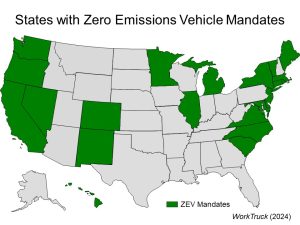Winter Without Your Gasoline Car?
January of this year brought near-zero temperatures to Chicago and other northern cites, producing an electric vehicle (EV) charging nightmare. National media showed images of owners pushing dead EVs around charging stations and waiting for hours to try to charge their vehicle. Drivers lucky enough to connect to a charger sat in their freezing-cold automobile, unable to run the heater while the car tried to charge. Nevertheless, the federal government and many states continue to push to eliminate gasoline vehicles.
On March 20, 2024, the Environmental Protection Agency announced a final rule, Multi-Pollution Emissions Standards for light vehicles sold in model years 2027 to 2032. The rule includes restrictions on the amount of carbon dioxide that can be emitted per mile, restrictions which most gasoline cars will be unable to meet. The goal of the rule is to force manufacturers to produce EVs for up to 56% of new light vehicle purchases by 2032.
Twenty-two states have adopted zero emissions vehicle (ZEV) mandates. California regulations call for 100% ZEV sales by 2035. Seventeen states have adopted the California ZEV regulations. Many of these are northern states with cold winters.

“Zero-emissions vehicle” effectively means electric vehicle. Hydrogen fuel-cell cars are failing to penetrate the US market. California has 55 public hydrogen fueling stations, but that number has been declining. Hawaii has a single hydrogen fueling station, the only other station in the US. Battery electric vehicles and plug-in hybrid EVs are the only vehicles that can meet the mandates at this time.
I recently met a guy from Cleveland at a conference whose wife had a Tesla. Two years ago, winter temperatures dropped to 10 degrees Fahrenheit at their home in Cleveland and her vehicle would not charge. She complained to the manufacturer to no avail.
In cold weather, electric vehicles lose driving range and take longer to charge. A 2020 study by the Norwegian Automobile Federation found an average loss of 18.5% in driving range during winter temperatures of 21─37 degrees Fahrenheit. Cold weather charging times increased up to 50 percent longer, depending upon car model. And as the woman in Cleveland found out, EVs will not charge at temperatures near zero degrees Fahrenheit.
A solution might be a heated garage or heated charging facility. But all US charging companies are losing money today, even without building heated public charging garages. About 30 percent of the US population lives in multi-unit housing, without a garage. Stretching a charging cable across a public walkway in the snow is a poor solution. And many homeowners with a garage do not park their car in their garage or cannot heat it.
Minnesota was the first midwestern state to adopt California’s ZEV regulations. The average high and low temperatures in St. Paul, Minnesota in January are 26oF and 7oF, poor conditions for EV charging. Montpelier, Vermont’s January average temperatures are the same as in St. Paul, with a 100% ZEV mandate in 2035 as well.
Maine’s mandate will require 43% of new vehicles sold by 2027 to be ZEV and 82% by 2032. But Augusta Maine’s average high and low January temperatures are 28oF and 11oF, not much warmer than Minnesota. Don’t state political leaders realize that gasoline car bans will force winter hardship on their citizens?
Last December, Canada mandated that all light-duty vehicles must be 100% zero emissions by 2035. Unless you have a heated garage in Canada, you soon won’t be able to charge your new EV for most of three months of the year.
In addition to the poor driving range and higher purchase price that comes with an EV, owners of cars in northern states will soon be forced to contend with poor performance in cold weather. Federal and state officials should reconsider their efforts to ban gasoline vehicles.
This commentary was first published at MasterResource on May 15, 2024.
Steve Goreham is a speaker on energy, the environment, and public policy, a member of the CO2 Coalition, and the author of the new bestselling book Green Breakdown: The Coming Renewable Energy Failure.
